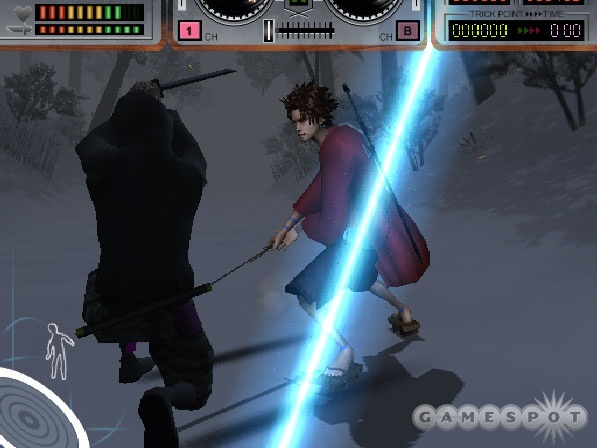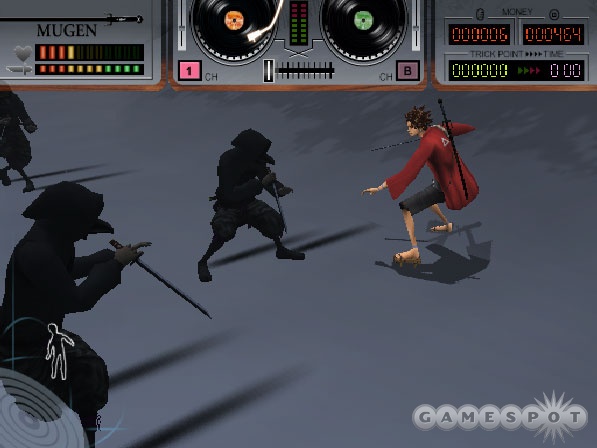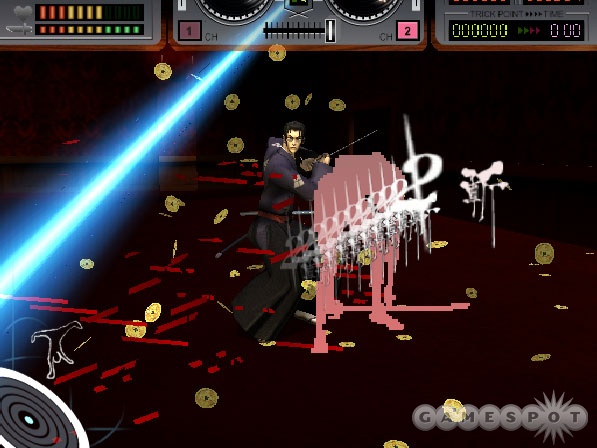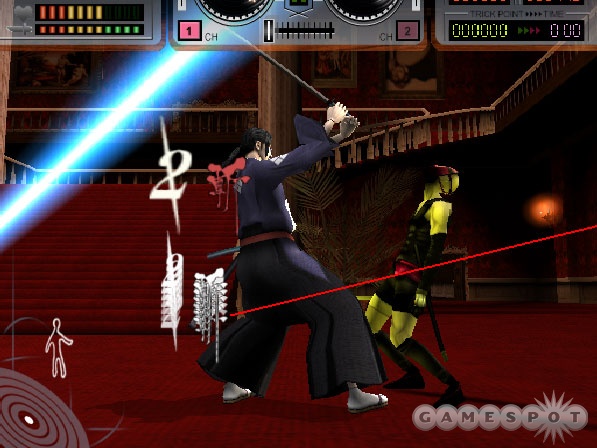Samurai Champloo: Sidetracked Hands-On
We get sidetracked with Mugen, Jin, and Fuu in this hip-hop-infused hack-and-slash based on the hit anime series.
Two rogue swordsmen, a perpetually famished former waitress, a samurai that smells of sunflowers, and hip-hop music galore. These are the main ingredients of Shinichiro Watanabe's (Cowboy Bebop, Macross Plus) masterful anime concoction Samurai Champloo, which airs on the Cartoon Network's Adult Swim late-night showcase. Fans of the series have been hoping for a Champloo-based game for some time now, and with the upcoming release of Samurai Champloo: Sidetracked, those hopes are about to be realized. Bandai dropped by our office yesterday to give us a hands-on look at this hip-hop-infused hack-and-slash game that looks to have just as much style as the show on which it's based.

The Samurai Champloo anime series follows the exploits of a trio of main characters--Mugen, Jin, and Fuu--as they travel through Edo-era Japan searching for a mysterious samurai "who smells of sunflowers." In Sidetracked, you'll play as either Mugen or Jin, both well known as two of the most dangerous sell-swords in all of Japan. Have no fear Fuu-fans, the plucky leader of the pack will make several appearances in the game--though more often than not, she'll be in need of a rescue after managing to get herself kidnapped.
Sidetracked's story starts off with the trio catching a boat while on the trail of the Sunflower Samurai, only to find out that the ship has taken them significantly off course to the northern Japanese island of Hokkaido. They find themselves sidetracked from their intended adventure (thus the title of the game), yet still manage to get into plenty of trouble along the way. Early on the in the game, you'll decide which swordsman you wish to control--the wild and untamed Mugen or the quiet and restrained Jin--and as you progress through the linear storyline, you'll experience the story from your chosen character's point of view. If you play through the game with the other hero, you'll get an entirely new perspective on the action. There's even an as-yet-unannounced third character you'll be able to control in Sidetracked, as well.
At its heart, Sidetracked is a hack-and-slash fighter set within the oddly anachronistic Champloo universe--one that melds Edo-era Japan with modern day hip-hop and slangy dialogue. In the game, you'll slice and dice your way through hordes of enemies, as well as numerous boss battles, with a fighting system that feels at once familiar and unlike practically anything we've seen before in the genre. Various swipes and slices are pulled off by hitting the face buttons on the controller, but the heart of the combat can be found in stringing together various combos to take down enemies quickly and powerfully. The combos available to you at any given time are dependent upon the music tracks playing on the turntables that appear at the top of the screen during combat. Confused yet? Let us try to explain.

At any time in combat, you can switch from one turntable to the next by pushing left or right with the right analog stick. Doing so will instantly switch not only the tune playing in the background, but also the move set available to your character. The full combo tree for the currently playing tune is shown at all times on the screen, so you won't have to memorize any combos if you don't want to. This hip-hop combo system is unique to Sidetracked, and it adds a degree of complexity that lifts the game above the standard hack-and-slash doldrums. In our brief hands-on time, we noticed that each tune seemed to have about three different branches for combos, but presumably, they get more complex the further you progress in the game.
Though you can "arm" only two combo tunes at any given time, the game will give you plenty of opportunities to purchase new songs (and thus new combos). To do this, you simply visit a music store in the town and pick up some new LPs. As you unlock new tunes, you'll need to make careful decisions about which two LPs you bring along with you for the next mission. Some tunes feature long combo strings that are ideal for taking out tough bosses, while other songs feature quick-hit combos that are designed for easier mobs. Choosing the right songs for the right occasions will benefit you in the long run.
During combat in Sidetracked, there is a lot happening on the screen. Combos and slashes are highlighted with great style, and the action moves quickly from enemy to enemy. As you fight, you build up a tension meter, and once it's filled, you enter "tate" (pronounced "tah-tay") combat mode where the action focuses solely on your character and your foe. The idea in tate mode is to strike your opponent as many times as possible within a certain time limit. Punish your foe sufficiently in tate mode, and you have a chance to enter "trance" mode, which is essentially a test of survival that requires you to stay alive while fighting wave after wave of enemies. Last long enough in trance mode (the length of the survival timer is tied to the length of the song playing in the background), and you can earn new weapons, items, or cash.

Beyond the music-based combo system, the game takes into account that both Jin and Mugen are radically different fighters. Because of this, each plays significantly different from the other. Jin is your standard stoic samurai whose fighting style revolves around whether his sword is sheathed or not. Fighting as Jin, your combo tree will change depending on what stance he is currently using. The animalistic Mugen, on the other hand, is much faster than his bespectacled counterpart, and probably a better character to use when starting out in the game. Mugen's untamed style, full of break-dancing backspins and violent kicks, is also a treat to watch on the screen.
Your base of operations in Sidetracked is a city in Hokkaido, and it's from this location that you'll be able to do things like visit shops, repair equipment, buy new LPs, and even visit vendors to take part in the game's handful of minigames. The city itself is a relatively free-roaming environment, complete with a handy overhead map, which illustrates areas you can visit and non-player characters you can interact with.
Along with visiting the record shop, we got a chance to check out a couple of the minigames in Sidetracked. The first, and arguably the best, starred Fuu in an eating contest that suits the eternally famished heroine. The goal is to stuff Fuu's face with as much food as you can in the allotted time by pressing the face buttons (Track & Field-style) as quickly as possible. At certain intervals, a button symbol appears onscreen--press it at the right time, and Fuu continues stuffing her face. Miss it, and Fuu will suffer a bad bout of "brain freeze," and the minigame is over. The second minigame we saw--a beetle battle where you place bets on which beetle will win in a titanic struggle for insect supremacy--was even stranger. It wasn't much to look at--in fact, it's not even really much to play--but it definitely had its oddball charm.
Much like the anime series' visuals, the game's graphics are an appealing mishmash of Japanese architecture and scenery, intercut with a load of screens and a presentation approach that is obviously influenced by hip-hop and remix culture. If this game is your first exposure to the Champloo universe, the stylistic contrasts can be jarring. If you're anything like us, though, it won't be long before you begin appreciating its distinct flavor. Beyond the stylistic conventions, the models of Mugen and Jin seem to be very faithful to the anime, and both moved quite quickly in combat, with plenty of cool, distinctive moves for dealing steel to the bad guys. By contrast, the game's backgrounds seemed a bit plain in comparison--in some cases the background scenery seemed to drop away completely. Whether this was a purposeful design choice or not wasn't clear, but it won't really matter anyway. You're not playing Sidetracked to enjoy the scenery, after all--you're playing it to kick samurai butt.

In all, Samurai Champloo seems like it will be a fairly faithful adaptation of the quirky anime series--one that isn't afraid to take a few chances with its gameplay. Time will tell if the gameplay will hold up after extended play, and we'll be sure to let you know how it goes in our full review. Sidetracked is set for release in the spring of this year. Until then, keep your eyes peeled and your nose sniffing for the sunflower samurai.
Got a news tip or want to contact us directly? Email news@gamespot.com
Join the conversation